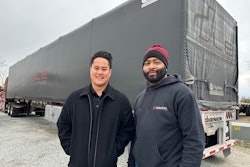
Any technologies – from electronic logging devices used to track hours of service to trailer tracking devices – that utilize the 3G network will no longer function by the end of the year as the last remaining carrier turns down its 3G network.
AT&T began the sunset of its 3G network in February, followed by Sprint 3G (T-Mobile) on March 31, Sprint LTE (T-Mobile) on June 30 and T-Mobile 3G on July 1. Now, Verizon is set to sunset its 3G network on Dec. 31.
Jennifer Coreno, product manager for connected devices at Verizon Connect, said they are on track to upgrade all impacted Verizon Connect vehicles in the U.S. by the end of the year and are not planning any extensions to the sunset deadline for fleet management customers.
With the deadline looming, several telematics providers are working to assist trucking companies in last-minute rushes to make the switch to networks with higher capability, including 4G and 5G.
“The ball really does drop on New Year’s Eve,” said Tony Nicoletti, vice president of business development at DPL Telematics. “Like anything, everybody waits to study for the test the night before, so people are scrambling last minute to update their devices. It's human nature, I think, to wait ‘til the last minute.”
Nicoletti said when there’s a sunset, there’s a major disruption for everybody, but it has been especially challenging this go ‘round because of supply chain disruptions preventing vendors from making upgrades due to lack of things like semiconductors. He said DPL has had several calls with customers recently who are behind on the transition, but 90%-plus of its customers have converted to the new network.
For Deseret Transportation, Fleet Manager Steven Roberts said the 3G sunset has been almost imperceptible so far.
“We did have to replace the telematics on some our refrigerated trailers. Of course, our in-cab telematics have received software updates to be compatible with the 5G, but we have not had to replace any units,” he said. “We did have a group with telematics from a company that basically would not work with the 5G so we had to switch them to a different provider, which required all new hardware.”
Nicoletti said Deseret’s latter situation in which it had to switch to a new provider is one some carriers will have to face if their vendors haven’t been able to upgrade their technology, which he said requires a lot of physical labor and extra cost when having to replace hardware in multiple units. The switch, he said, is having an impact on carriers’ bottom lines if they haven’t built in that capital to make these technological advances. And if they’ve waited until the last minute to handle the transition, he said their devices will officially go dark, if they haven’t already, Dec. 31, further impacting their pocketbooks as it could result in shutting down operations.
Knight-Swift Transportation (CCJ Top 250, No. 5) has stayed on top of the transition. For example, the carrier began the process of replacing more than 20,000 soon-to-be outdated trailer tracking units for dry van trailers in 2020. Management took the two years ahead of the 3G shutdown to evaluate, test and install a 4G-enabled telematics platform, ultimately choosing SkyBitz’s Falcon GXT5002C asset tracking solution with integrated cargo sensor and making the switch ahead of schedule despite COVID-19 restrictions and supply chain disruptions.
Siamak Azmoudeh, vice president of product lifecycle management and business development at SkyBitz, said all of the company’s customers, which were primarily running on the AT&T network, have made the jump to 4G with very few having a handful of trailers that continue to roam.
SkyBitz was able to negotiate with AT&T to extend its 3G services by allowing customers to roam on the T-Mobil network to give them six additional months for the transition.
“It’s not an easy thing to do, especially depending on the size of fleet you have. It's not an easy transition whenever you have to go and replace units,” Azmoudeh said. “But I think we've gotten over the hump, and I think most customers are where they need to be.”
Thought fleets knew this shutdown was coming, many have failed to prepare. He said this network shutdown has opened eyes to the importance of making the transition early but also has taught carriers to give more thought to what technologies they’re buying into.
“I think customers learned during that process, and now when they're looking at investing in new technologies, they're thinking, ‘How long is this going to last for me? Is it something that is going to sunset quickly?’” he said. “I think it was a pretty good eye opener in a way and helps customers understand even more when they're thinking about investing in technology.”
He said the good news is with SkyBitz technology, customers will be able to retain their devices for another 15 to 20 years, even as additional network expansion comes forth.
Similar to 2G and 3G, Nicoletti said the 4G network should be remain online for five to seven years before a full transition to the next spectrum is required. With 4G, Nicoletti said networks have built a narrower bandwidth that requires less power and provides greater reach dedicated to telematics and other IoT services so they don’t have to compete with individuals streaming video on their iPhone, for example.
Coreno said Verizon Connect customers are already seeing the benefits of that.
Texas-based equipment rental company KRP Rentals and Trucking said, as a result of its new 4G LTE devices, it is getting faster response times on pinging and getting more accurate data about where its assets are.
“It is important for any remaining 3G fleets to move fast as time is running out until vehicles stop reporting as a result of the 3G sunset,” Coreno said.
She said carriers need to discuss with their current fleet management provider to verify which of their vehicles and devices need an upgrade from 3G and determine what the best approach to that switch is. During this process all vehicles should be evaluated – the year, make and models associated with 3G devices on their fleet, she said. From there, 4G hardware recommendations can be made, and with Verizon Connect, customers can select the installation type that is most convenient for them, including self-install options and hidden (behind the dashboard) installations.
“Who keeps a computer or phone for seven years because it becomes obsolete and slow? That being said, if you find a vendor that has a product that will last seven years, that’s a great vendor. I’d stick with that vendor no matter what,” Nicoletti said. “But by the time that seven-year mark rolls around, you'll probably be wanting to look to upgrade to whatever the latest and greatest is anyway.”











